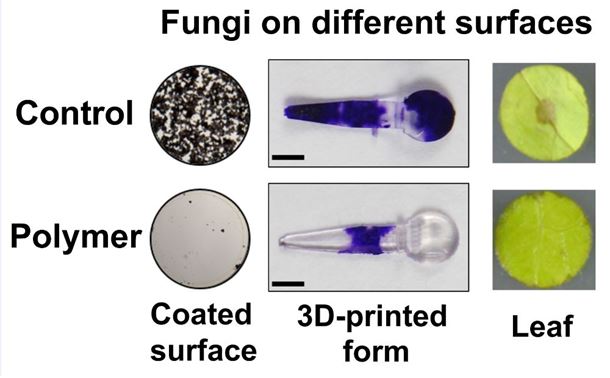“This is the first high-throughput study of polymer chemistries resisting fungal attachment”Simon Avery
Researchers from the University of Nottingham in the UK have developed a new passive, anti-attachment approach to controlling the diverse problems associated with harmful fungi – such as human disease, ruined food crops, and the biodeterioration of products and materials. Although it helps to resist fungi attachment, the approach does not depend on the use of chemical bioactives such as fungicides or antifungals, and could lead to new sprays to control crop disease, coatings for biomedical devices prone to fungal pathogens and everyday surfaces liable to fungal contamination.
There is a need for a new approach to control destructive fungi as existing strategies using antifungals and fungicides are losing their value because of growing resistance, while interest in technologies that use bioactive agents are being constrained due to regulatory and environmental concerns. This all makes new bioactive-free approaches to combatting harmful fungi potentially very advantageous for industry.
As reported in Science Advances [Vallieres et al. Sci. Adv. (2020) DOI: 10.1126/sciadv.aba6574], the team identified polymers that are resistant to the attachment of different kinds of fungi, such as pathogens, using a coating of (meth)acrylate polymers. They screened hundreds of such polymers in high throughput, identifying some that reduce the attachment of the human pathogen Candida albicans, the crop pathogen Botrytis cinerea, and other fungi. A formulation was developed with the materials for inkjet-based 3D printing, with components showing up to 100% reduction in C. albicans biofilm versus commercial materials, and they also printed parts for medical devices that were able to resist fungal colonization.
Specific chemical features of the polymers were associated with weak fungal attachment. In addition, the materials were non-toxic, which supports their passive utility. For instance, spray-coated leaf surfaces that resisted fungal infection were demonstrated, with no evidence of plant toxicity. By being passive, this alternative fungal control strategy doesn't require the same sort of 'killing affect' of fungicides, and the materials can be incorporated into products to counteract fungal deterioration. As lead investigator Simon Avery said: “This is the first high-throughput study of polymer chemistries resisting fungal attachment”.
The team is now looking to explore chemical modifications to tailor and optimize properties of the polymer materials for various proposed applications. They would also like to test the coated materials in the relevant application settings – for example, by progressing towards field trials for crop disease, or potential clinical trials for medical devices. A similar technique for bacterial pathogens for a catheter coating to prevent infections in medical patients is another possibility.
